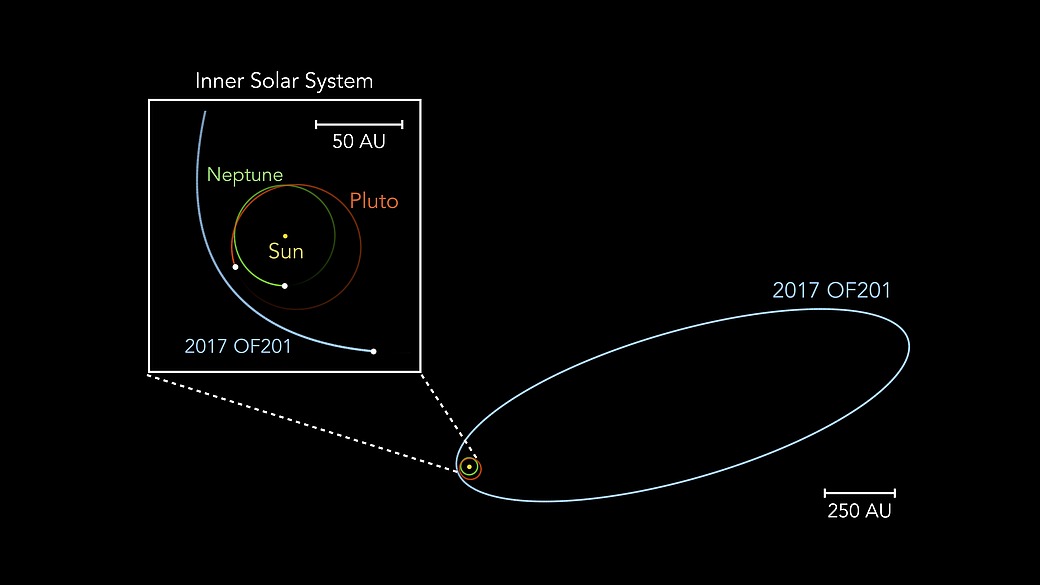We reach more than 65,000 registered users in Dec!! Register Now

An Extreme Cousin for Pluto? Possible Dwarf Planet Discovered at Solar System’s Edge
- September 12, 2025
- 241 Views
- 0 Likes
- 0 Comment
A small team led by Sihao Cheng, Martin A. and Helen Chooljian Member in the Institute for Advanced Study’s School of Natural Sciences, has discovered an extraordinary trans-Neptunian object (TNO), named 2017 OF201, at the edge of our solar system.
The TNO is potentially large enough to qualify as a dwarf planet, the same category as the much more well-known Pluto. The new object is one of the most distant visible objects in our solar system and, significantly, suggests that the empty section of space thought to exist beyond Neptune in the Kuiper Belt is not, in fact, empty at all.
Cheng made the discovery alongside colleagues Jiaxuan Li and Eritas Yang from Princeton University, using advanced computational methods to identify the object’s distinctive trajectory pattern on the sky. The new object was officially announced by the International Astronomical Union’s Minor Planet Center on May 21, 2025, and in an arXiv pre-print shared today.
Trans-Neptunian objects are minor planets that orbit the Sun at a greater average distance than the orbit of Neptune. The new TNO is special for two reasons: its extreme orbit and its large size.
“The object’s aphelion—the farthest point on the orbit from the Sun—is more than 1600 times that of the Earth’s orbit,” explains Cheng. “Meanwhile, its perihelion—the closest point on its orbit to the Sun—is 44.5 times that of the Earth’s orbit, similar to Pluto's orbit.”
“Many extreme TNOs have orbits that appear to cluster in specific orientations, but 2017 OF201 deviates from this,” says Li. This clustering has been interpreted as indirect evidence for the existence of another planet in the solar system, Planet X or Planet Nine, which could be gravitationally shepherding these objects into their observed patterns. The existence of 2017 OF201 as an outlier to such clustering could potentially challenge this hypothesis.
Cheng and his colleagues estimate 2017 OF201’s diameter to be 700 km, which would make it the second largest known object in such a wide orbit. The diameter of Pluto, meanwhile, is 2,377 km. Further observations, potentially using radio telescopes, are needed to determine the object's exact size.
The discovery has significant implications for our understanding of the outer solar system. The area beyond the Kuiper Belt, where the object is located, has previously been thought to be essentially empty, but the team’s discovery suggests that this is not so.
“2017 OF201 spends only 1% of its orbital time close enough to us to be detectable. The presence of this single object suggests that there could be another hundred or so other objects with similar orbit and size; they are just too far away to be detectable now,” Cheng states. “Even though advances in telescopes have enabled us to explore distant parts of the universe, there is still a great deal to discover about our own solar system.”
The detection also demonstrates the power of open science. “All the data we used to identify and characterize this object are archival data that are available to anyone, not only professional astronomers,” says Li. “This means that groundbreaking discoveries aren't limited to those with access to the world's largest telescopes. Any researcher, student, or even citizen scientist with the right tools and knowledge could have made this discovery, highlighting the value of sharing scientific resources.”
List of Referenes
- Sihao Cheng, Jiaxuan Li, Eritas Yang. Discovery of a dwarf planet candidate in an extremely wide orbit: 2017 OF201. arXiv, 21 May 2025] DOI: 10.48550/arXiv.2505.15806
Cite This Article as
No tags found for this post









